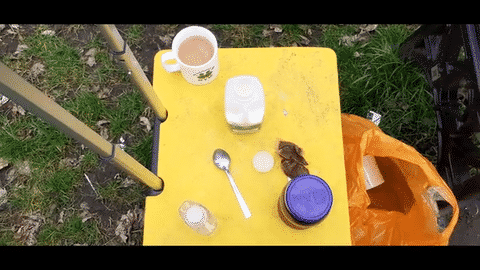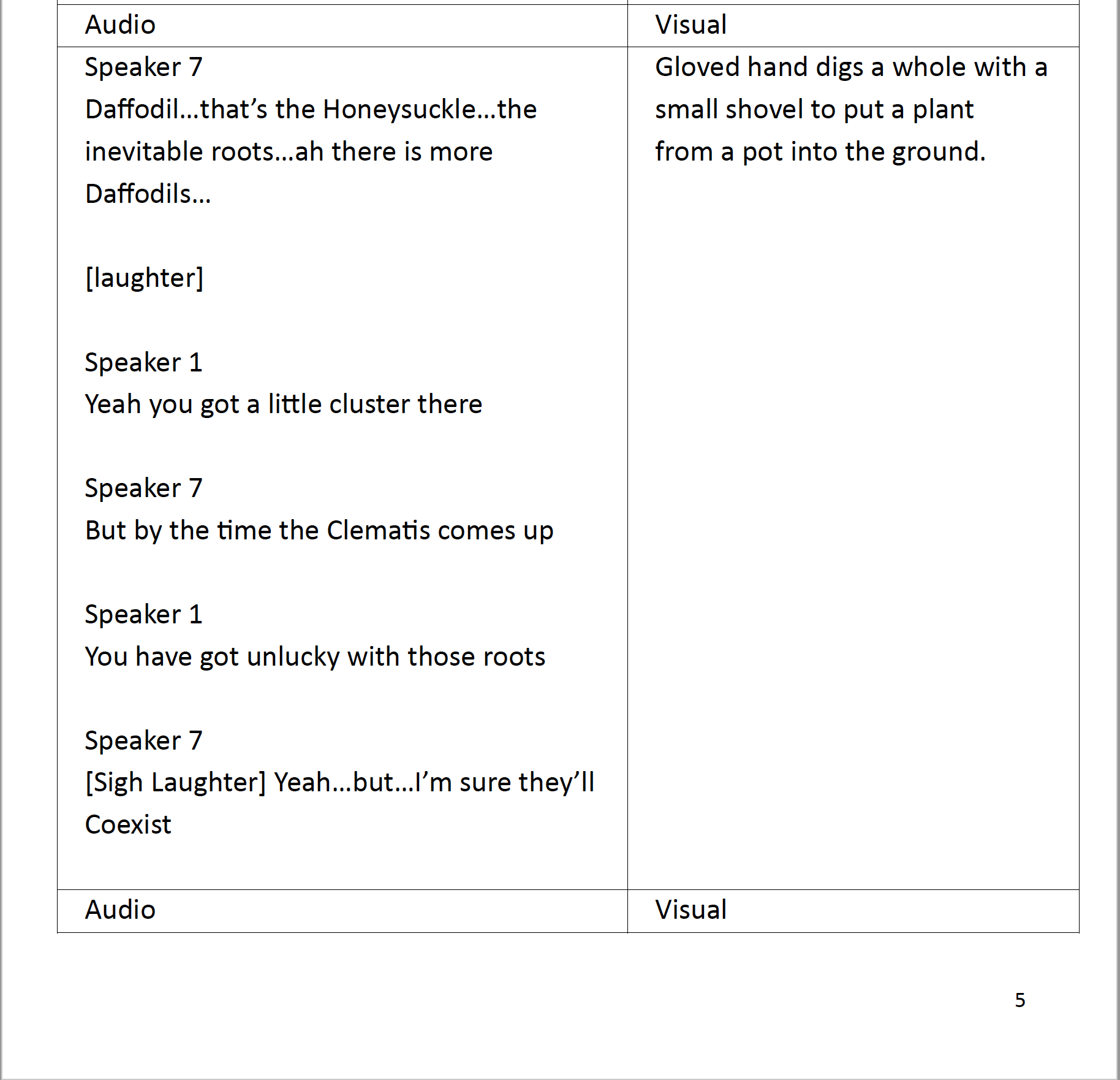Rhiannon Hunter
assemblage - edit - collage - diffraction - story - cut - join - telling - anecdote - timespace - splice -
Reading [2 minutes 31 seconds]
Reading & Audio Visuals [4 minutes 28 seconds]
Reading & Audio Visuals [4 minutes 28 seconds]
1. Storying
To engage in land ecologies and conservation is to live with constant dilemmas around what and how decisions are made in the management of land, non-human and human beings, and what narratives are told and re-told.
Doings of Care works across different modalities of information gathering, transfer and narration and seeks to echo the multiplicity of engaging with urban nature spaces. Amid fragmentary moments, meaningful questions surface about kinship, conservation, care and acts of noticing.
Doing involves participating in bodily actions of touch and attunement with other entities and beings that creates opportunities for knowledge transfer. To observe someone walking in water in waders is different to wearing waders and feeling the water’s power, its agency against one’s own body.
Silt, pebbles, grind underneath my steadying foot, my hips twist as the cool power of the water embraces my outstretched calf to funnel with giddy ease between my waders. [1]
The process of filming and image capture both documents and severs action’s ties with a specific time-location, to reconstruct events in a film-time-space through storying. Recorded sound waves are thick with data about their production, of bodily exchanges between other beings, of seasonality and colliding temporalities. Audible bird calls, flying insects, snapping branches, digging, a droning aeroplane, a hissing boiling kettle are layered sonics that drift into each other and disrupt scale and linear sequential events.This disruption speaks of the indivisibility of time and space as it is formed through ‘co-generation’” [2](Vogelin, 2023, p.46). Sound’s storying speaks of the interconnectedness and liveliness of all beings vibrating as one sonic-soup.
The gist is the essence of something summarised for ease of recollection and translation. They are mobile, fragmented gifts of information that move linguistically from one mouth to the ear of another. In doing so, they are imbued with metadata – a time(stamp), location, author, lived experience - that link them to a moment – to a non-event-event taking place that is relational between social beings caught in exchange. Gists move as an autonomous common currency of sharing knowledge that can provide insights that enable one to orientate oneself within the complexity of experiencing environments. Gists can move as an anecdote that ‘as it circulates it shapes the ways in which particular incidents come to be understood' (Micheal, M, 2021, p25) [3] They are rebellious forms of sharing that create haphazard social bonds and unofficial networks of exchange that evade dominant structures of ordering information, people and living worlds for capital gain and commodification.
![]()
Doings of Care works across different modalities of information gathering, transfer and narration and seeks to echo the multiplicity of engaging with urban nature spaces. Amid fragmentary moments, meaningful questions surface about kinship, conservation, care and acts of noticing.
Doing involves participating in bodily actions of touch and attunement with other entities and beings that creates opportunities for knowledge transfer. To observe someone walking in water in waders is different to wearing waders and feeling the water’s power, its agency against one’s own body.
Silt, pebbles, grind underneath my steadying foot, my hips twist as the cool power of the water embraces my outstretched calf to funnel with giddy ease between my waders. [1]
The process of filming and image capture both documents and severs action’s ties with a specific time-location, to reconstruct events in a film-time-space through storying. Recorded sound waves are thick with data about their production, of bodily exchanges between other beings, of seasonality and colliding temporalities. Audible bird calls, flying insects, snapping branches, digging, a droning aeroplane, a hissing boiling kettle are layered sonics that drift into each other and disrupt scale and linear sequential events.This disruption speaks of the indivisibility of time and space as it is formed through ‘co-generation’” [2](Vogelin, 2023, p.46). Sound’s storying speaks of the interconnectedness and liveliness of all beings vibrating as one sonic-soup.
2. The ‘Gists of Things
The gist is the essence of something summarised for ease of recollection and translation. They are mobile, fragmented gifts of information that move linguistically from one mouth to the ear of another. In doing so, they are imbued with metadata – a time(stamp), location, author, lived experience - that link them to a moment – to a non-event-event taking place that is relational between social beings caught in exchange. Gists move as an autonomous common currency of sharing knowledge that can provide insights that enable one to orientate oneself within the complexity of experiencing environments. Gists can move as an anecdote that ‘as it circulates it shapes the ways in which particular incidents come to be understood' (Micheal, M, 2021, p25) [3] They are rebellious forms of sharing that create haphazard social bonds and unofficial networks of exchange that evade dominant structures of ordering information, people and living worlds for capital gain and commodification.
3. Care

Care is not
‘nice, cozy relations’ [4] (Abrahamsson and Bertoni, 2014, cited in Puig de la Bellacasa, 2015, p707). To
care is radical. It is a mode of engagement with self, other, human and
non-human that operates and generates its own value system aside from dominant systems
of accumulation and endless growth. Care is the time it takes for - and to film
- gloved hands that dig earth to make a hole for a plant to take root.
![]()
To undertake care is to dedicate time to the process of maintenance, reproduction and the ‘creating liveable and lively worlds’ [5] (Puig de la Bellacasa, 2017, p.209) through everyday acts of doing, maintenance, noticing.

To undertake care is to dedicate time to the process of maintenance, reproduction and the ‘creating liveable and lively worlds’ [5] (Puig de la Bellacasa, 2017, p.209) through everyday acts of doing, maintenance, noticing.
I
too enter the thigh-high water and attempt to coordinate my arms, torso and
cutters to remove the reeds. The air is sulphurous from disturbed pond matter,
breath and ice hover in condensing clouds, an upturned snail shell bobs, bitter
tea and bourbon biscuits, chattered talk, with engine hums. Volunteers trickle
away in different directions. My tyres have left a line in the ice
crisped grass as I stop recording, feet numb, I leave the common for the
tarmac. [1]
![]()
[2] Voegelin, Salomé (2023). Uncurating sound: knowledge with voice and hands. New York: Bloomsbury Academic.
[3] Micheal, M. (2012), ‘Anecdote’ in Wakeford, N, and Lury, C (ed.), Inventive methods: the happening of the social,
[4]Puig de la Bellacasa, M. (2015). ‘In Making time for soil: Technoscientific futurity and the pace of care’, Social Studies of Science, Vol. 45(5) pp. 691–716. DOI: 10.1177/0306312715599851 sss.sagepub.com
[5]Puig de la Bellacasa, M. (2017). ‘Soil_Times_The_Pace_of_Ecological_Care’, Matters of Care: Speculative Ethics in More Than Human Worlds, Minnesota Press, pp.169-215>
De La Bellacasa, M, P. (2017) ‘Soil Times: The Pace of Ecological Care.’ Matters of Care: Speculative Ethics in More than Human Worlds, University of Minnesota Press, pp.169–216. JSTOR, Available: http://www.jstor.org/stable/10.5749/j.ctt1mmfspt.8. (Accessed: 19 Mar. 2023). Quote by Papadopoulos, Dimitris, 2011. “Alter-ontologies: Towards a Constituent Politics in Technoscience.” Social Studies of Science 41, no. 2: 177–201.
LaBelle, B. (2020), Sonic Agency Sound and Emergent Forms of Resistance, London, Goldsmiths Press.
Todd, Z., Kanngiesser, A. (2020), ‘Attending to Environment as Kin Studies’
From digital forum Constellations. Indigenous Contemporary Art from the Americas, Hyundai Tate Research Centre: Transnational and The Museo Universitario Arte Contemporáneo (MUAC), Available: https://muac.unam.mx/constelaciones/assets/docs/essay-kanngieser-and-todd.pdf(Accessed: 2022)

4. References
[1] Journal Entries
[2] Voegelin, Salomé (2023). Uncurating sound: knowledge with voice and hands. New York: Bloomsbury Academic.
[3] Micheal, M. (2012), ‘Anecdote’ in Wakeford, N, and Lury, C (ed.), Inventive methods: the happening of the social,
Routledge, p.25
[4]Puig de la Bellacasa, M. (2015). ‘In Making time for soil: Technoscientific futurity and the pace of care’, Social Studies of Science, Vol. 45(5) pp. 691–716. DOI: 10.1177/0306312715599851 sss.sagepub.com
[5]Puig de la Bellacasa, M. (2017). ‘Soil_Times_The_Pace_of_Ecological_Care’, Matters of Care: Speculative Ethics in More Than Human Worlds, Minnesota Press, pp.169-215>
Also
De La Bellacasa, M, P. (2017) ‘Soil Times: The Pace of Ecological Care.’ Matters of Care: Speculative Ethics in More than Human Worlds, University of Minnesota Press, pp.169–216. JSTOR, Available: http://www.jstor.org/stable/10.5749/j.ctt1mmfspt.8. (Accessed: 19 Mar. 2023). Quote by Papadopoulos, Dimitris, 2011. “Alter-ontologies: Towards a Constituent Politics in Technoscience.” Social Studies of Science 41, no. 2: 177–201.
LaBelle, B. (2020), Sonic Agency Sound and Emergent Forms of Resistance, London, Goldsmiths Press.
Todd, Z., Kanngiesser, A. (2020), ‘Attending to Environment as Kin Studies’
From digital forum Constellations. Indigenous Contemporary Art from the Americas, Hyundai Tate Research Centre: Transnational and The Museo Universitario Arte Contemporáneo (MUAC), Available: https://muac.unam.mx/constelaciones/assets/docs/essay-kanngieser-and-todd.pdf(Accessed: 2022)